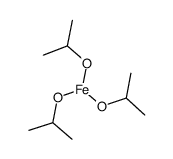异丙氧基铁(III) ,Iron (III) i-propoxide ,99%
产品编号:Bellancom-B413042| CAS NO:14995-22-3| 分子式:C3H8FeO| 分子量:115.9384
本网站销售的所有产品仅用于工业应用或者科学研究等非医疗目的,不可用于人类或动物的临床诊断或者治疗,非药用,非食用,
| 产品名称 | 异丙氧基铁(III) |
|---|---|
| 英文名称 | Iron (III) i-propoxide |
| CAS编号 | 14995-22-3 |
| 产品沸点 | 82℃ |
| 产品密度 | 0.79 |
| 产品闪点 | 12°(54°F) |
| 精确质量 | 233.08400 |
| PSA | 27.69000 |
| LogP | 2.62460 |
| 外观性状 | solid | brown to black |
| 溶解性 | It hydrolyzes with water. |
| 稳定性 | 遵照规定使用和储存则不会分解。 |
| 储存条件 | 密闭于阴凉干燥环境中 |
相关文档
化学品安全说明书(MSDS)
下载MSDS质检证书(COA)
相关产品
| 危险品运输编码 | UN3180 |
|---|---|
| 包装等级 | III |
| 危险类别 | 4.1 |
|
Section 1: Product Identification Chemical Name:Iron (III) i-propoxide (99.9+%-Fe) CAS Registry Number:14995-22-3 Formula:Fe(OC3H7)3 EINECS Number:None Chemical Family:metal alkoxide Synonym:Ferric propoxide, Iron propylate
Section 2: Composition and Information on Ingredients IngredientCAS NumberPercentACGIH (TWA)OSHA (PEL) Title Compound14995-22-3100%1 mg/m3 (Sol Fe)no data Section 3: Hazards Identification Emergency Overview:Irritating to skin, eyes and respiratory tract. Primary Routes of Exposure:Ingestion, skin, inhalation, eyes Eye Contact:Causes slight to mild irritation of the eyes. Skin Contact:Causes irritation, redness, and pain to skin. Inhalation:Irritating to the nose, mucous membranes and respiratory tract. Ingestion:No information on the physiological effects of ingestion. Acute Health Affects:Irritating to skin, eyes and respiratory tract. Prolonged ingestion may lead to damage to the liver and pancreas. Prolonged inhalation of dusts may cause Chronic Health Affects: pulmonary fibrosis. NTP:No IARC:No OSHA:No SECTION 4: First Aid Measures Immediately flush the eyes with copious amounts of water for at least 10-15 minutes. A victim may need Eye Exposure: assistance in keeping their eye lids open. Get immediate medical attention. Wash the affected area with water. Remove contaminated clothes if necessary. Seek medical assistance if Skin Exposure: irritation persists. Remove the victim to fresh air. Closely monitor the victim for signs of respiratory problems, such as difficulty Inhalation: in breathing, coughing, wheezing, or pain. In such cases seek immediate medical assistance. Seek medical attention immediately. Keep the victim calm. Give the victim water (only if conscious). Induce Ingestion: vomiting only if directed by medical personnel. SECTION 5: Fire Fighting Measures Flash Point:53°F(2-propanol) Autoignition Temperature:none Explosion Limits:none Extinguishing Medium:carbon dioxide, water, foam or dry powder If this product is involved in a fire, fire fighters should be equipped with a NIOSH approved positive pressure Special Fire Fighting Procedures: self- contained breathing apparatus and full protective clothing. Hazardous Combustion andIf involved in a fire this material may emit irritating fumes. Decomposion Products: Unusual Fire or Explosion Hazards: Contact with moisture will produce flammable isopropanol SECTION 6: Accidental Release Measures Remove sources of ignition. Small spills can be mixed with vermiculite, sodium carbonate or other suitable non Spill and Leak Procedures: combustible adsorbent and swept up. SECTION 7: Handling and Storage Keep material in a tightly sealed container in a cool dry place. Prolonged exposure to the moist air will result in Handling and Storage: degradation of the product. Handle and store material under a dry atmosphere. SECTION 8: Exposure Controls and Personal Protection Eye Protection:Always wear approved safety glasses when handling a chemical substance in the laboratory. Skin Protection:Wear protective clothing and gloves. Ventilation:Material may form a fine dust. If possible, handle the material in an efficient fume hood. If ventilation is not available a respirator should be worn. The use of respirators requires a Respirator Respirator: Protection Program to be in compliance with 29 CFR 1910.134. Ventilation:Material may form a fine dust. If possible, handle the material in an efficient fume hood. Additional Protection:No additional protection required. SECTION 9: Physical and Chemical Properties Color and Form:brown to black solid Molecular Weight:233.12 Melting Point:no data Boiling Point:no data Vapor Pressure:no data Specific Gravity:no data Odor:slight alcohol odor Solubility in Water:hydrolyzes in water SECTION 10: Stability and Reactivity Stability:moisture sensitive Hazardous Polymerization:no hazardous polymerization Prolonged contact with air or moisture. Keep away from heat and ignition sources including open flame and Conditions to Avoid: electrostatic discharge. Incompatibility:Oxidizing agents, halogens and active metals Decomposition Products:carbon dioxide, carbon monoxide, organic fumes, and iron oxide SECTION 11: Toxicological Information RTECS Data:No information available in the RTECS files. Carcinogenic Effects:No data Mutagenic Effects:No data Tetratogenic Effects:No data SECTION 12: Ecological Information Ecological Information:No information available SECTION 13: Disposal Considerations Disposal:Dispose of according to local, state and federal regulations. SECTION 14: Transportation Shipping Name (CFR):Non-hazardous Hazard Class (CFR):NA Additional Hazard Class (CFR):NA Packaging Group (CFR):NA UN ID Number (CFR):NA Shipping Name (IATA):Non-hazardous Hazard Class (IATA):NA Additional Hazard Class (IATA):NA Packaging Group (IATA):NA UN ID Number (IATA):NA SECTION 15: Regulatory Information TSCA:Not listed in the TSCA inventory. SARA (Title 313):Title compound not listed. Second Ingredient:None SECTION 16 - ADDITIONAL INFORMATION N/A |








 浙公网安备 33010802013016号
浙公网安备 33010802013016号